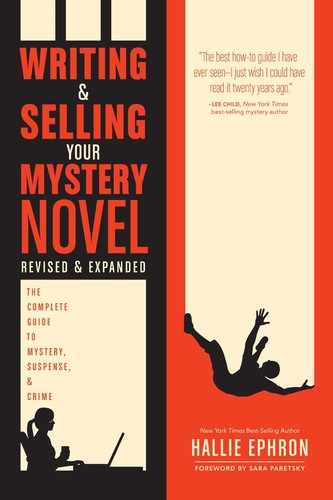Part III
Revising
“What’s nice about writing is that nothing’s set in stone till it’s finished. It’s only then that you hang yourself out to dry.”
—Evan Hunter (a.k.a. Ed McBain)
When I type THE END on a first draft, I celebrate. Ta-dah! Strike up the band! Break open the champagne! The hardest part (for me) is over, and the fun is about to begin.
Not everyone shares my enthusiasm for revision. But whether you love it, loathe it, or fall somewhere between those two extremes, there’s one thing we can all agree on: No one writes a publishable first draft. Plot and characterization are bound to need fixing; word choice, spelling, and grammar will surely need to be tweaked.
So when you’ve finished the manuscript, take a moment to pat yourself on the back. Print out the manuscript and set it aside, taking a week or two off to recuperate—you need a break so you’ll be able to look at your work with fresh eyes. Then dive into the next phase: revision.
My revision strategy, in a nutshell, is to take a cleansing breath and then work from large to small.
- Back up your manuscript. You should, of course, have been doing this all along, but if you haven’t, make a backup copy. You can back up the file to a backup drive on your personal computer, but also back it up to device that’s not in your house. I e-mail mine to myself and also back it up to cloud storage. If you use a service to put it in the cloud, be sure you understand whether the service will encrypt the file and protect your privacy.
- Print it out, and take a break. You’ve run the spell-checker, fussed with the margins, and altered the font to see how that changes the page count. One day you love it; the next day all you see are flaws. You know the truth lies somewhere in between. To revise effectively, you need perspective, so print the whole thing out and take a break for a week or two at least. Go fishing, build a birdhouse, take a trip to New Jersey—anything to keep yourself from picking at the manuscript.
- Prepare to slash and burn: Open the OUT file. It can be hard to murder your darlings—to delete those cherished words you labored over. So make it easier. Instead of throwing words away, set them aside for safekeeping. If you haven’t already done so while you were writing, create an OUT file now where you can paste any words that you cut from your manuscript. If you change your mind later, you’ll know where to find them.
- Fly high over your manuscript; identify the big changes needed. Reread the manuscript and, at the same time, give it to a few trusted readers to critique. Compile a list of major revisions needed, such as plot shifts, character adjustments, or slow spots that need firming up.
- Make the big fixes. Rewrite, handling the biggest issues first and working your way down to smaller ones.
- Fly low over your manuscript; identify the small changes needed. Read your revision, and do a careful line edit. Clean up the spelling, grammar, and punctuation; remove redundancies; improve your word choices; tweak dialogue; clarify unintended ambiguities.
- Start over. Take it from the top! Repeat the entire process until you’re certain that the manuscript is as good and as squeaky-clean as you can get it.
How long does revision take? This varies greatly from writer to writer and project to project, but revising a first novel can take as long or longer than it took to write. I wrote my first novel in a year and revised it for three. Really. After ten published novels, I take at least ten months to write and ten weeks to revise, and often I wish I could take longer.
How good is good enough? This is one of the hardest questions to answer. How do you know when a manuscript is finished and you can stop revising? It’s a gut feeling, based on your own instincts and feedback from trusted readers. Many writers hire a freelance editor to give their manuscript a thumbs-up or thumbs-down and a final polish. I recommend this, especially if you plan to self-publish.
Is there such a thing as too much revision? There’s certainly such a thing as revising the wrong stuff. That’s what happens when you hear a writer say, “I rewrote it and sucked the life out of it.” The trick is to figure out what’s not working and fix it, and to figure out what is working and leave it alone.
The chapters in this section provide advice for how to thoroughly revise your manuscript so it’s ready to be launched.
